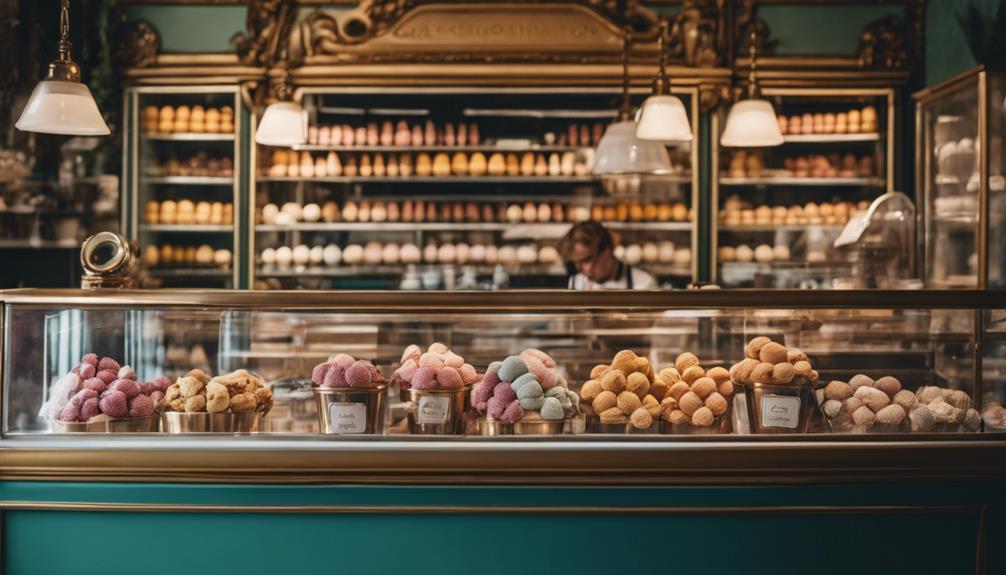While in Milan, make sure to indulge in some of the top-notch gelato available. Popular establishments such as Gelato Fatto Con Amore and Antica Gelateria Sartori serve unique flavors crafted with premium ingredients. Whether you prefer classic pistachio or are interested in trying out new options like ricotta and fig, there’s something to satisfy every palate. The velvety texture and intense flavors of each scoop showcase the city’s expert artisanal skills. Enhance your gelato experience by pairing it with local pastries. Stay a while to uncover additional hidden treasures in Milan’s gelato scene.
Key Takeaways
- Milan's gelato scene features both traditional flavors like pistachio and innovative options such as lavender-honey, emphasizing high-quality ingredients.
- Iconic gelaterias like Gelato Fatto Con Amore and Antica Gelateria Sartori offer unique flavors and exceptional craftsmanship, making them must-visit spots.
- The artisanal process results in a denser, creamier texture, with a higher milk-to-cream ratio enhancing flavor intensity.
- Health-conscious options, including vegan and dairy-free gelato, are increasingly available, catering to diverse dietary preferences.
Overview of Gelato in Milan

Milan's gelato scene offers a delightful mix of traditional and innovative flavors that reflect the city's rich culinary heritage. You'll find artisanal gelaterias around every corner, each dedicated to crafting authentic taste through high-quality natural ingredients. Unlike ice cream, gelato features lower fat content, typically ranging between 4-9%, which gives it a denser and creamier texture. This unique composition allows the flavors to shine, ensuring you experience a burst of taste with every scoop.
As you explore the city, you'll notice a remarkable variety of flavors. While classic options like pistachio and stracciatella are always a hit, many gelaterias push boundaries with innovative flavors, such as lavender-honey or spicy chocolate. Whether you prefer a vegan option or something dairy-free, the gelato scene in Milan accommodates all dietary preferences, ensuring everyone can indulge.
In Milan, gelato isn't just a dessert; it's a cultural experience. Each visit to a gelateria invites you to savor not only the delicious treats but also the lively atmosphere that surrounds you. So, grab a cone and immerse yourself in this enchanting world of gelato!
Historical Context of Gelato

Originating in ancient Rome and Egypt, gelato has a rich history that reflects the evolution of frozen desserts enjoyed by the elite. Gelato's origins can be traced back to these ancient civilizations, where nobility indulged in frozen treats.
The modern version took shape during the Renaissance in Florence, where architect Bernardo Buontalenti introduced it to the Medici court, transforming the dessert into a refined delicacy.
By the 16th century, the first gelato shop emerged in Florence, marking the beginning of gelato's commercial production. This period also saw the rise of skilled artisans who honed their craftsmanship, experimenting with flavors and techniques.
Since the 1930s, Milan's artisans have continued this tradition, contributing to the evolution of gelato with innovative recipes and high-quality ingredients. In 2010, gelato was recognized by UNESCO as part of Italy's cultural heritage, underlining its importance in Italian culinary traditions.
Today, when you savor gelato in Milan, you're not just enjoying a delicious treat; you're partaking in a centuries-old tradition that embodies Italy's rich history and dedication to craftsmanship.
Characteristics of Gelato

When you taste gelato, you'll notice its unique texture and density right away.
It has a creaminess that comes from a lower fat content and less air, making each scoop feel indulgent yet light.
This combination elevates the flavor intensity, allowing you to truly savor every bite.
Texture and Density
Gelato's unique texture and density set it apart from traditional ice cream, delivering a rich and creamy experience that delights the palate. With its lower fat content, typically ranging from 4% to 9%, creamy gelato boasts a velvety mouthfeel that's hard to resist. The artisanal gelato-making process involves less air than ice cream, resulting in a denser texture that enhances the unique flavors.
Here's a quick comparison:
| Characteristic | Gelato | Ice Cream |
|---|---|---|
| Fat Content | 4% – 9% | 10% – 20% |
| Air Content | Less air (denser texture) | More air (lighter texture) |
| Serving Temperature | Slightly warmer | Colder |
| Milk-to-Cream Ratio | ~70% milk | Higher cream ratio |
This combination of lower fat levels, a higher milk-to-cream ratio, and minimal air content creates a silky, indulgent treat that's both satisfying and flavorful. When you savor gelato, you're enjoying not just a dessert but a carefully crafted experience that showcases the artistry behind each scoop.
Flavor Intensity Factors
The higher milk-to-cream ratio in gelato markedly boosts its flavor intensity, allowing the taste of natural ingredients to take center stage. When you indulge in authentic gelato, you'll notice how the lower fat content (4-9%) lets the flavors shine through. Unlike ice cream, which can coat your palate, gelato delivers a richer taste experience.
Here are three key factors that enhance flavor intensity in gelato:
- Denser Texture: Gelato is churned at a slower speed, incorporating less air. This denser texture means each bite is packed with flavor.
- Warmer Temperature: Served at slightly warmer temperatures, gelato releases flavor compounds more quickly, making every taste explosion feel immediate and satisfying.
- Local Ingredients: Authentic gelato often relies on local ingredients and traditional techniques, ensuring that each scoop reflects the purest and most vibrant flavors.
Next time you're in Milan, look for gelato shops that emphasize these factors. You'll appreciate how they elevate the overall tasting experience, making your gelato flavors unforgettable! When searching for the best gelato brands, pay attention to the quality of the ingredients, the texture of the gelato, and the creativity of the flavors. These factors can make all the difference in your gelato experience and leave you craving for more. Whether it’s a traditional flavor or a unique combination, the best gelato brands will surely leave a lasting impression.
Popular and Unique Flavors

When you're in Milan, you can't miss the classic flavors like Pistachio and Tiramisu that have stood the test of time.
But don't stop there; be sure to explore unique creations like Ricotta and Fig that show just how inventive gelato can be.
With a mix of traditional favorites and bold new tastes, you're in for a delicious adventure.
Timeless Flavor Favorites
In Milan, timeless flavor favorites like Pistachio and Stracciatella delight locals and visitors alike, showcasing the rich, creamy textures that define authentic gelato. These classic flavors are a must-try when you seek the best gelato in Milan. They highlight the artisanal craftsmanship and high-quality ingredients that gelaterias pride themselves on.
Here are three beloved flavors you shouldn't miss:
- Pistachio: With its nutty flavor profile, this classic is a staple, often made with real pistachios for an intense taste.
- Stracciatella: A creamy base swirled with fine chocolate shavings, this flavor offers a delightful contrast in texture.
- Tiramisu Gelato: Combining mascarpone, coffee, and ladyfingers, this unique gelato captures the essence of the iconic Italian dessert.
Don't forget to explore seasonal flavors like Lemon and Frutti di bosco, which utilize fresh local ingredients. These invigorating options not only cleanse your palate but also reflect the changing seasons.
Whether you prefer timeless favorites or unique gelato, Milan's gelaterias offer something special for every ice cream lover.
Innovative Flavor Creations
Milan's gelaterias aren't just about timeless favorites; they're also a playground for innovative flavor creations that surprise and delight adventurous palates.
You'll find gelato artisans showcasing their creativity with bold combinations that push the boundaries of traditional flavor profiles. For instance, at Ciacco, you might encounter a daring Strawberry and Kimchi sorbet that redefines your expectations.
Emphasizing an artisanal approach, many gelaterias incorporate local ingredients, crafting unique combinations like Ricotta and Fig. This reflects a deep connection to Milan's culinary heritage while keeping the flavors fresh and exciting.
Popular spots like Cioccolatitaliani take this further by specializing in chocolate-based gelato, offering unique flavors such as Nutella and salted caramel that cater to chocolate lovers.
While classics like Stracciatella and Pistachio remain beloved, the innovative flavors you discover will leave a lasting impression.
These creations highlight the talent of Milan's gelato artisans, who are committed to providing an unforgettable experience.
Iconic Gelaterias in Milan

Exploring the iconic gelaterias of Milan reveals a delightful variety of flavors and experiences that every gelato lover should savor. Here are three must-visit spots that showcase the best gelato shops in the city: The first stop on any gelato tour of Milan should be Grom, which is celebrated for its high-quality ingredients and dedication to traditional methods of gelato-making. Another not-to-be-missed spot is CioccolatItaliani, where you can indulge in some of the best milano gelato paired with rich, decadent chocolate. Finally, don’t leave Milan without sampling the innovative flavors at Gelateria della Musica, known for its creative combinations that tantalize the taste buds.
- Gelato Fatto Con Amore: Known for its exceptional pistachio gelato, this artisanal shop offers a unique interior that enhances your gelato experience. Don't miss it from Tuesday to Sunday, 12:00 pm to 10:00 pm.
- Antica Gelateria Sartori: Established in the 1930s, this gem near Milan Centrale serves a delicious combination of gelato and Sicilian granita. The signature hazelnut flavor is a crowd-pleaser, and it's open until midnight on weekends.
- LatteNeve: If you're looking for vegan options, head to this hidden gem in the Navigli neighborhood. Their creamy gelato with dark chocolate chunks will leave you wanting more, welcoming visitors from Sunday to Thursday, 12:30 pm to 10:30 pm.
Each of these gelaterias reflects a commitment to quality and offers unique flavors that define the Milanese gelato experience.
Don't miss out!
Gelato Culture and Trends

Gelato culture thrives on a mix of traditional recipes and innovative flavors that keep locals and visitors excited about this beloved treat.
In Milan, gelaterias are embracing artisanal techniques, ensuring that each scoop reflects a commitment to authenticity. Many shops are now using organic ingredients, emphasizing quality and sustainability while crafting their gelato.
You'll notice a growing trend towards innovative flavors, with gelaterias experimenting by incorporating local ingredients and seasonal offerings. This creativity not only attracts a diverse clientele but also keeps the gelato scene fresh and exciting. Plus, many establishments are catering to health-conscious consumers by introducing vegan options and dairy-free alternatives, ensuring that everyone can indulge without compromise.
Social media plays a significant role in shaping Milan's gelato culture. Visually stunning gelato presentations encourage patrons to share their experiences online, effectively promoting artisanal shops and their unique flavors.
The communal aspect of enjoying gelato in inviting spaces fosters social interactions, making each visit a cherished experience. In Milan, you don't just taste gelato; you become part of a vibrant culture that celebrates this delightful treat.
Recommendations for Visitors
When you visit, make sure to indulge in the local gelato scene by trying a variety of flavors at the city's top gelaterias. Milan is known for its artisanal gelato, and you'll want to experience the best offerings during your stay.
Here are three recommendations to guide your gelato journey:
- Artico Gelateria: Don't miss the unique mascarpone ice cream paired with brioche. The cozy atmosphere and diverse menu make it a perfect stop for a sweet treat.
- Gelateria Sartori: As one of the oldest gelaterias in Milan, it's a must-visit for traditional craftsmanship. Their signature hazelnut gelato and Sicilian granita are simply unforgettable.
- Ciacco Gelato senzaltro: For those seeking innovative flavors, this spot offers vegan, gluten-free, and lactose-free options made from natural ingredients. You can indulge guilt-free!
Gelato Pairing Suggestions

To enhance your gelato experience, consider pairing it with local pastries or rejuvenating desserts that complement its rich flavors and textures.
For instance, enjoy a creamy stracciatella gelato from a top gelateria in Milan alongside a rich espresso. This combination creates a delightful contrast that'll excite your palate.
If you're in the mood for something invigorating, try lemon gelato paired with a light panna cotta. This duo acts as a perfect palate cleanser, balancing sweetness with a hint of acidity.
You can also indulge in artisanal mascarpone gelato served in a warm brioche—an innovative twist that showcases the versatility of Italian gelato.
Lastly, seasonal fruit sorbets like raspberry or peach can elevate your tasting experience when served with a cheese platter. The sweetness of the sorbet contrasts beautifully with savory cheese, creating a harmonious balance.
Frequently Asked Questions
Who Is the Best Gelato Company in Italy?
When you're searching for the best gelato company in Italy, you can't overlook Gelato Giusto for its unique flavors, Il Massimo del Gelato for chocolate lovers, and Antica Gelateria Sartori for traditional excellence.
What Is the Number One Gelato in the World?
When you savor gelato, it's like tasting a piece of heaven. The title of the number one gelato in the world varies; personal preferences, ingredients, and artistry all play crucial roles in your experience.
Who Won Best Gelato in the World?
You'll find that the title of Best Gelato in the World in 2023 was awarded to Gelateria Dondoli. Its unique flavors and artisanal techniques truly set it apart, showcasing the dedication to quality and creativity.
How Do You Pick Good Gelato in Italy?
Picture yourself savoring a rich pistachio gelato. To pick good gelato in Italy, look for natural ingredients, creamy texture, muted colors, diverse flavors, and don't hesitate to sample before you decide on your favorite.
Conclusion
In Milan, indulging in gelato isn't just a treat; it's an unforgettable experience that'll elevate your taste buds to cloud nine.
With a rich history and a dazzling array of flavors, the city's gelaterias are a must-visit.
Don't miss out on sampling unique combinations and classic favorites alike.
So, grab a cone and savor the creamy delight that makes Milan a gelato lover's paradise—because once you've tasted it, you'll never want anything else!
















